
Moorcroft Armorial Salt Glaze Vase with Ribbed Neck Design
Rare Moorcroft armorial salt glaze vase, c.1928-1949, of baluster form with ribbed hand thrown design to the neck, featuring a shield shaped armorial design with inset flower, on a dark blue mottled ground, impressed made in England//Moorcoft//'Potter to…

Rare William Moorcroft 'Angelfish' Salt Glaze Vase, c. 1935
Large and rare William Moorcroft 'Angelfish' salt glaze vase, c.1935, hand thrown, of slightly waisted baluster form, terminating in a wide sloping foot, depicting two fish, in mottled blue tones, impressed W.Moorcroft//Moorcroft// potter to H.M the Queen…

Moorcroft 'Powder Blue' Coffee Set with 12 pieces
Moorcroft 'Powder Blue' coffee set, comprising coffee pot, creamer and saucer, sugar bowl, four demitasse and four saucers, all containing impressed marks, (12)

Moorcroft 'Banded Honesty' Salt Glaze Vase, c.1929, 26 cm
William Moorcroft 'Banded Honesty' salt glaze vase, c.1929, of tapering ovoid form, decorated with a main frieze of honesty plant, surrounded by narrower friezes of stylised flowers heads and foliage, impressed Moorcroft//Made in England and signature,…

Moorcroft Pansy Sugar Bowl & Cream Jug by W.M
Moorcroft Pansy design sugar bowl and cream jug, both signed 'W.M.' for William Moorcroft, and impressed Cobridge factory mark to base. Circa 1918-1926. Height 7 cm jug

William Moorcroft Pomegranate Tea Set with Pewter Mounts
A William Moorcroft 'Pomegranate' three-piece tea set, cylindrical tapering form with hand beaten pewter mounts, the set includes a teapot with sugar bowl and cream jug, impressed marks and signature to base, chip to the base of sugar and cream jug.
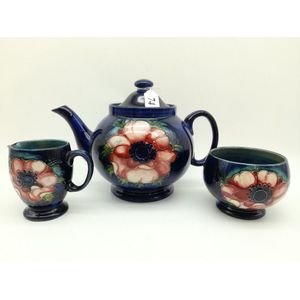
Moorcroft Anemone Tea Set
Pottery tea set Moorcroft Pottery, three piece set comprising of teapot, sugar bowl and creamer decorated with anemone flowers against cobalt blue ground by Walter Moorcroft, signed at base

Moorcroft MacIntyre Pepper and Mustard Pots, Damaged
Moorcroft MacIntyre pepper pot and mustard pot, 2 5.5 cm - 6.5 cm high, the pepper pot with chip to under side of top rim, mustard pot with crack to base and lid a/f
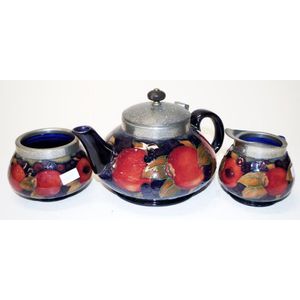
Moorcroft Pomegranate Tea Set with Pewter Fittings
Rare three piece Walter Moorcroft tea set 'Pomegranate,' pattern on blue ground, including teapot, milk jug, and sugar bowl, each with pewter fittings, marked to bases, height 13 cm.

Moorcroft Fish Vase
Early 20th century Moorcroft fish themed vase salt glazed example minimistically decorated with two blue fish and signed to base William Moorcroft and impressed 'Potter to H. M. The Queen', height 25 cm

Uncommon Moorcroft Salt Glazed Leaf and Berry Vase
An uncommon Walter Moorcroft 'Leaf and Berry' salt glazed vase, ovoid form, the unusual colour tonings resulting from the salt glazed effect to the standard 'Leaf and Berry' pattern, impressed marks and blue painted full signature. Height 21 cm.

Moorcroft Fish Vase
William Moorcroft, salt glaze vase, c. 1930, Fish' pattern, decorated with fish swimming amongst aquatic plants, signed in blue 'W. M', impressed 'Moorcroft, Made in England, height 20.5 cm. Provenance: Private Collection, NSW
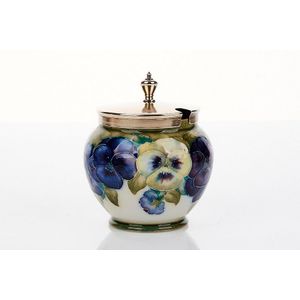
Moorcroft Macintyre Pansy Sugar Pot, 1912
William Moorcroft for Macintyre, sugar pot, c. 1912, Pansy' pattern, decorated with a continuous band of pansies and leaves against a cream ground, signed in green 'W. M.', brown printed Macintyre mark and 'D & H B, height 11.5 cm. Provenance: Private…
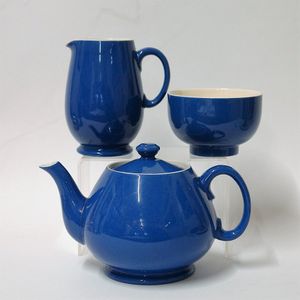
William Moorcroft 'Powder Blue' Tea Set from Liberty's
A William Moorcroft 'Powder Blue' three-piece tea set, comprising teapot, sugar and cream, impressed marks. As retailed and used in the Liberty's of London tea rooms.

Moorcroft Landscape Salt Glaze Vase
William Moorcroft, salt glaze vase, c. 1925, Landscape' pattern, decorated with five trees on a landscape background, signed in blue 'W. Moorcroft', impressed 'Moorcroft Made in England', height 24 cm. Provenance: Private Collection, NSW

Moorcroft 'Powder Blue' Liberty Coffee Set, 1920s
Moorcroft 'Powder Blue' coffee set consisting of 6 trios, coffee pot and sugar bowl, designed for Liberty of London tearooms, c.1920's

Moorcroft Plum Teaset with Pewter Mounts
Moorcroft three piece teaset plum pattern comprising teapot, sugar & cream with pewter mounts

Moorcroft Powder Blue Condiment Set with Markings
Moorcroft 'Powder Blue' three piece condiment set, marked to base

Moorcroft Salt Glaze Vase with Fresia Design
Moorcroft 'Fresia' salt glaze vase on a cream ground, signed & impressed marks to the base, height 22.3 cm

Moorcroft Powder Blue Teaset, 1920s
Moorcroft powder blue teaset, comprising of 6 cups with saucers, a milk jug and sugar bowl, circa 1920s

Moorcroft Pansy Sugar Caster with Pewter Mounts, 17cm
Moorcroft tapering sugar caster Pansy pattern with pewter hammered finish mounts, 17 cm high

Moorcroft Landscape Waisted Vase in Salt Glaze
Rare Moorcroft waisted vase landscape pattern in sombre salt glaze, 21 cm high

Moorcroft Claremont Condiment Set, 1914
William Moorcroft, Claremont condiment set, 1914, impressed marks 'Moorcroft, Burslem, 1914', Heights up to 7 cm, diameter 4.5 cm (widest), weight 168g (total)

Moorcroft Poppy Vase, Blue Signature, 15.5 cm
William Moorcroft salt glaze 'poppy' vase, blue signature and impressed mark to base, height 15.5 cm approx

William Moorcroft Freesia Salt Glaze Vase
A William Moorcroft 'Freesia' salt glaze vase circa 1930 of baluster form the body decorated with freesia. Height 23 cm. Signed to base

Moorcroft Fish Jug
A William Moorcroft salt glaze 'Fish' jug circa 1930 of baluster form the body decorated with three fish swimming amongst foliage and water lilies. Height 17.3 cm. Signed to base

Rare William Moorcroft Anenome Vase - 16cm
Rare William Moorcroft salt glazed Anenome vase 16 cm high approx.

Moorcroft Duck Egg Blue Creamer and Sugar Bowl Set
Moorcroft duck egg blue glaze sugar bowl & creamer having a white interior, with impressed 'Moorcroft Made in England' stamp to the base. Condition good, some crazing. Height of jug 8.8 cm

Vintage Blue Moorcroft Breakfast Service
A vintage blue Moorcroft twenty piece part breakfast service, the mottled mid blue setting comprising four cups and associated saucers, three side plates, two teapots, two creamers, a toast rack, two egg cups and a salt and pepper pair, as found; with…
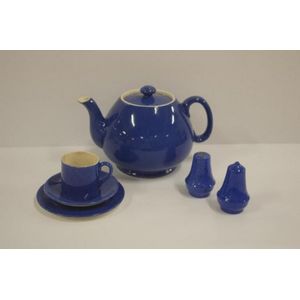
Moorcroft Powder Blue Tea Set with Salt and Pepper
Moorcroft 'Powder Blue' teapot, coffee trio, plus salt and pepper shakers
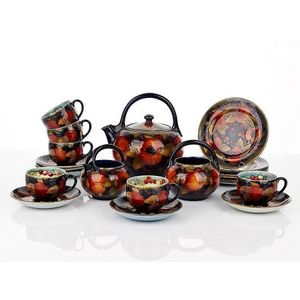
Moorcroft Pomegranate Tea Set
William Moorcroft tea service 'Pomegranate' pattern including teapot, cream jug, sugar bowl, six tea cups and saucers, signed to base 'Moorcroft', impressed to base 'Moorcroft' and 'Made in England'. Height 20 cm (teapot)

Moorcroft Sugar Gliders Vase
Moorcroft sugar gliders vase. Designed by Vicky Lovatt, 2008. Height 23 cm

Moorcroft Pansy Cream Jug and Sugar Bowl Set
A William Moorcroft Pottery Pansy cream jug and sugar bowl first designed 1911. Signed with impressed factory marks. Jug height 7.8 cm bowl diameter 8.8 cm

Moorcroft Pomegranate Tea Set
Moorcroft pomegranate tea set, including jug, sugar, teapot, cup/saucer and teapot stand

Moorcroft Powder Blue Coffee Set
Moorcroft powder blue coffee pot and six coffee cans with saucers and sugar bowl

 Loading more...
Loading more...